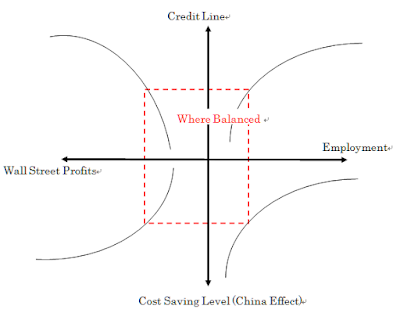EEE-4-Axis Analaysis Method
Japan and the US have made smart use of cheap labor force in China.
But, it has an adverse effect on both Japan and the US. It has taken a form of explicit deflation in Japan but big unemployment and deterioration of social/economic status of the lower middle class in America.
With advanced science, technology, and management systems, Japan and the US in the late 20th century looked like having no problems well into the 21st century. But, global competition was intensified. It was partly due to rivalry between businesses of Japan and the US or among themselves. But it was also partly driven by unregulated greedy of capitalism that requested more profits and more returns.
A Japanese company had to compete with other Japanese companies so that they opted for using cheaper labor force in China rather than building more factories in Japan and hiring more Japanese workers. A US company, sch as Wal-Mart, was requested to increase profitability more by stake holders and equity holders in Wall Street. They opted for importing cheap products and material from China rather than using products and material made in the US. This trend has resulted in explicit long-term deflation in Japan and in sudden increase in unemployment and deterioration of status of lower-middle-class Americans after the 2008 Financial Crisis which took away false credit capability of ordinary American households.
As a result, as the above figure shows, though both Japan and the US have strong advantage in international competition, their levels of sate of national finance and people's living standard have received the downward force from the China factor. Of course, as counteraction, hundreds of millions of Chinese have been pulled up from the poverty line. Ironically, due to the greedy strategy of the Japanese industry and Wall Street players to use cheap labor force in China, those who manage the Japanese industry and Wall Street business get richer but ordinary people get poorer in Japan and the US while many Chinese get rich though Chinese economy lacks solid foundation.
This is one example of applying the EEE-Anaysis Method using four axes.
If you have two items to study and you can find two factors that have an influence on these items, you can use the above EEE-Analysis Method where the two factors are divided into a positive factor and a negative factor for the targeted items.
Now let's check a little different relationship between the four axes.
If a credit ceiling for each consumer is set at a higher level, consumers will be able to buy more and businesses will be able to sell more. Many new jobs will be created, and a need for finance will increase to make Wall Street make good deals. But, on the other hand, global competition penetrates into the American market. Business will have to cut human costs and reduce the number of employees while securing enough profits for corporate management and investors in Wall Street. So, politics will have to set this balance. At present, the 2008 Financial Crisis broke this balance, lowering the ceiling level of credit while the international competition among businesses is all the more intensified claiming more cost cuts.
(to be continued...)
*** *** *** ***
Today it snowed in various parts of Japan, including Kyoto.
One of the best winter scenes in Japan is the Kinkaku-ji (the golden Buddhist temple) which is otherwise called Rokuon-ji (the deer garden temple), built in 1397.
http://blog.goo.ne.jp/kamiyu-6581/e/2e9f427e7147acbfc22bbcde9b9a0071
As Kyoto City is situated in a basin separated from Osaka Bay (connected to the Pacific Ocean) and the Sea of Japan, it is very cold in winter. But Tokyo faces the Pacific Ocean directly over Tokyo Bay, so that only several times it snows in Tokyo in the winter. Anyway there are many Japanese who really want to take a picture of the Kinkaku-ji surrounded by snow covered trees. It really invokes the sense of wabi and sabi of the winter version.
Joh 12:26 If any man serve me, let him follow me; and where I am, there shall also my servant be: if any man serve me, him will my Father honour.





